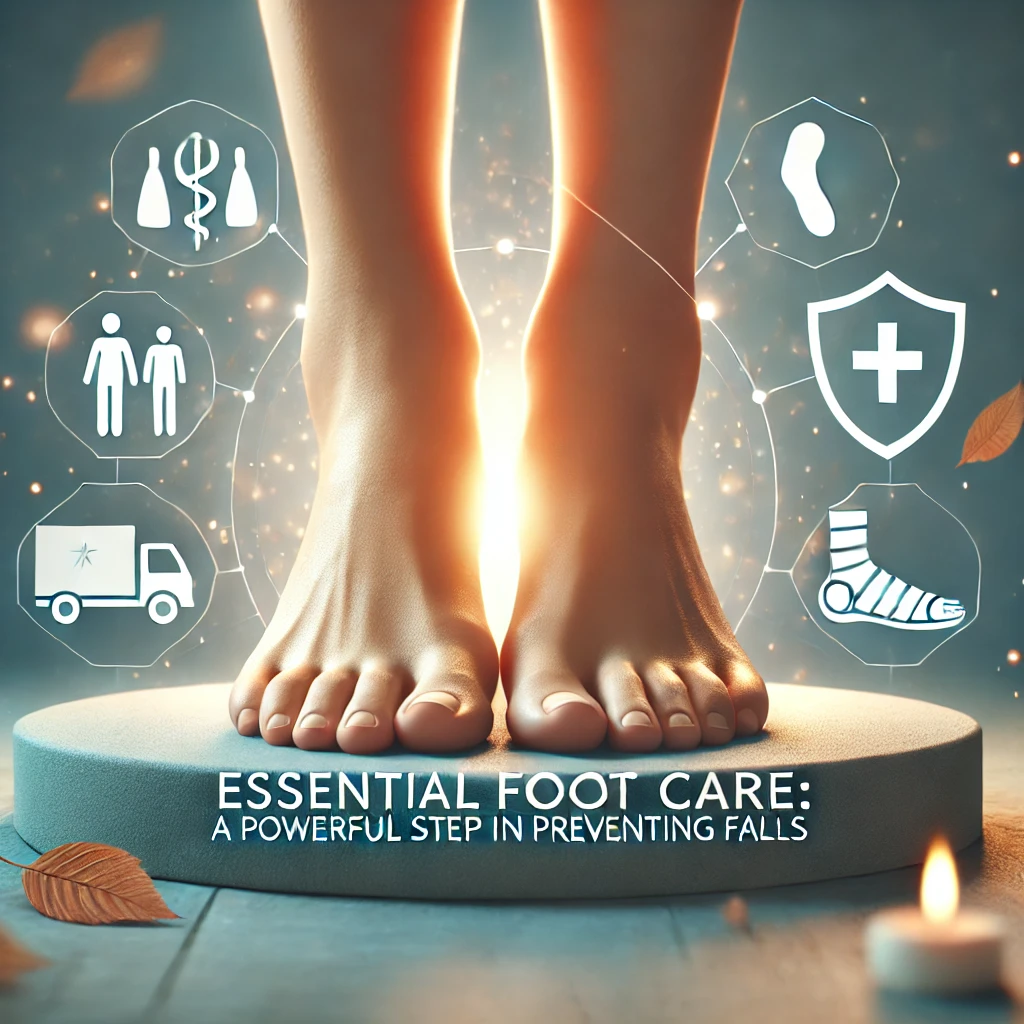Introduction
Our feet are the unsung heroes of our body, carrying us through every step of our daily lives. Yet, they’re often overlooked until a problem arises. Maintaining healthy feet isn’t just about comfort—it’s essential for overall well-being and mobility. Neglecting foot health can lead to issues like pain, infections, and long-term complications. Let’s dive into practical daily habits that ensure your feet stay in top condition.
Understanding Your Feet

Anatomy of the Foot
The human foot is a complex structure of 26 bones, 33 joints, and over 100 muscles, tendons, and ligaments. It’s designed to bear weight, provide balance, and absorb shock, making it a marvel of engineering.
How Feet Support Your Body
Your feet act as the foundation of your body, supporting your weight and enabling movement. Healthy feet improve posture, balance, and overall physical health.
Signs of Unhealthy Feet
Pay attention to signs like persistent pain, swelling, or discoloration. These could indicate underlying issues such as infections, poor circulation, or even systemic conditions like diabetes.
Daily Habits for Maintaining Healthy Feet

Proper Hygiene Practices
Keeping your feet clean is non-negotiable. Wash them daily with warm water and mild soap to remove dirt, sweat, and bacteria. After washing, dry your feet thoroughly, especially between the toes, to prevent fungal infections like athlete’s foot.
Regular Moisturizing
Dry, cracked skin on your feet can lead to discomfort and infections. Use a hydrating foot cream or lotion daily, focusing on the heels and soles. Avoid applying moisturizer between the toes to reduce the risk of fungal growth.
Choosing the Right Footwear
Your shoes play a pivotal role in foot health. Opt for footwear that provides proper arch support, a cushioned sole, and a snug but not tight fit. Avoid high heels and narrow-toed shoes for daily wear, as they can cause bunions and other deformities.
Regular Nail Care
Trim your toenails straight across to prevent ingrown nails. Use clean clippers and avoid cutting nails too short. If you notice discoloration or thickening of the nails, consult a podiatrist for evaluation.
Daily Foot Exercises
Simple exercises can enhance flexibility and strength. Try toe stretches, rolling a tennis ball under your foot, or practicing balance exercises to keep your feet strong and agile.
Preventing Common Foot Problems

Managing Sweaty Feet
Excessive sweating can lead to odor and fungal infections. Wear breathable socks made from natural fibers like cotton or moisture-wicking materials. Use foot powders or antiperspirants designed for feet to keep them dry.
Avoiding Foot Infections
Fungal infections like athlete’s foot thrive in moist, warm environments. To prevent them, keep your feet dry, wear clean socks daily, and avoid walking barefoot in public places like pools or locker rooms.
Caring for Calluses and Corns
Calluses and corns are caused by friction and pressure. Use a pumice stone to gently exfoliate these areas after bathing, and apply a thick moisturizer to keep the skin soft. Avoid cutting them yourself, as it can lead to infections.
Foot Massage and Relaxation Techniques

Benefits of Foot Massage
Foot massages are more than a luxurious treat—they are a therapeutic way to maintain foot health. Regular massages improve blood circulation, reduce stress, and relieve muscle tension. This practice is particularly helpful after long hours of standing or physical activity.
Massages also stimulate pressure points connected to other parts of the body, promoting overall relaxation. Reflexology, a type of massage that targets specific areas of the foot, is known to provide benefits for organs and muscles throughout the body.
Simple At-Home Techniques
You don’t need a professional masseuse to pamper your feet. Use your thumbs to apply gentle pressure to your arches and heels. Rolling a tennis ball or massage roller under your feet is another effective technique to relieve soreness. Warm oil massages can also help hydrate and rejuvenate tired skin.
Incorporate massage into your nightly routine for relaxation and long-term foot health benefits.
Benefits of Regular Foot Check-Ups

When to Visit a Podiatrist
Routine visits to a podiatrist should be a staple of your foot care regimen. Why? Because many foot problems, like bunions, ingrown toenails, and plantar fasciitis, can be caught early with professional attention. A podiatrist can provide tailored advice, treatments, and interventions to keep your feet in optimal health.
If you have conditions such as diabetes or arthritis, regular check-ups are even more critical. These conditions often affect the feet, leading to nerve damage, ulcers, or joint issues. Early detection and management can prevent severe complications.
Identifying Foot Health Red Flags
Your feet can reveal a lot about your overall health. Swelling, persistent pain, or changes in skin color can signal problems ranging from circulation issues to infections. For example, red or swollen feet might indicate gout, while numbness could be a sign of nerve damage.
By recognizing these red flags early, you can address minor issues before they escalate into significant health concerns, such as diabetic foot ulcers or arthritis-related deformities. Routine monitoring helps you stay proactive.
Footwear and Orthotics

Role of Orthotics in Foot Health
Orthotics are custom-designed shoe inserts that provide support and alignment for your feet. These can be a game-changer for those with flat feet, high arches, or chronic conditions like plantar fasciitis.
The benefits of orthotics extend beyond comfort—they can help reduce joint pain, improve posture, and enhance mobility. Whether you’re an athlete or simply on your feet all day, investing in custom orthotics can prevent strain and injuries.
When choosing orthotics, consult a specialist to ensure they meet your specific needs. Over-the-counter options might offer temporary relief, but custom ones are designed for long-term benefits.
Seasonal Footwear Tips
Your choice of footwear should change with the seasons. In summer, opt for sandals with arch support to keep your feet cool and comfortable. Avoid flip-flops for long walks, as they lack adequate cushioning and support.
In winter, insulated boots with non-slip soles are essential to protect your feet from frostbite and icy surfaces. Always prioritize fit and comfort over style to keep your feet healthy year-round.
Tips for Special Groups
Foot Care for Athletes
Athletes put tremendous pressure on their feet, making them prone to injuries like sprains, stress fractures, and blisters. To prevent these issues, always wear proper sports shoes designed for your activity. These shoes provide the necessary support and cushioning to absorb shock.
Recovery routines, such as soaking feet in Epsom salt baths or applying ice packs, can help relieve soreness after intense activity. Stretching exercises for your toes, arches, and Achilles tendon also aid in keeping your feet strong and flexible.
Foot Care for Seniors
As we age, our feet undergo changes that affect mobility and balance. Thinning skin, reduced cushioning, and joint stiffness can lead to discomfort or an increased risk of falls.
Seniors should prioritize wearing well-fitted shoes with non-slip soles and ample support. Regular foot massages and stretching exercises can help maintain flexibility and circulation. Additionally, routine check-ups are crucial to monitor for issues like bunions, arthritis, or diabetic foot complications.
The Importance of a Balanced Diet for Foot Health

Nutrients That Support Strong Feet
A well-balanced diet plays a vital role in maintaining healthy feet. Calcium and vitamin D are essential for strong bones, preventing conditions like osteoporosis that can affect the feet. Foods rich in omega-3 fatty acids, such as salmon and flaxseeds, reduce inflammation in joints and tissues.
Magnesium, found in nuts, seeds, and leafy greens, helps prevent muscle cramps and improves circulation. Proper hydration is equally important to avoid swelling and discomfort in the feet.
Foods to Avoid
Limit the intake of foods high in sugar and refined carbohydrates, as these can lead to inflammation and exacerbate conditions like arthritis. Also, excessive salt can cause water retention, leading to swollen feet.
By prioritizing a diet rich in nutrients and low in inflammatory foods, you can ensure your feet stay strong, flexible, and pain-free.
Conclusion
Caring for your feet isn’t just about aesthetics; it’s about ensuring your overall health and mobility. By adopting daily habits like proper hygiene, choosing the right footwear, and incorporating exercises, you can keep your feet in top shape. Regular visits to a podiatrist and recognizing early warning signs can prevent serious problems down the road. Make foot care a priority—it’s a small investment for a lifetime of comfort and activity.
Frequently Asked Questions
1. How often should I moisturize my feet?
Moisturize your feet at least once daily, preferably after a shower or bath, to keep the skin hydrated and prevent cracks.
2. What are the best shoes for foot health?
Shoes with good arch support, cushioned soles, and a roomy toe box are ideal. Avoid high heels and flat-soled shoes for extended wear.
3. How can I prevent blisters during exercise?
Wear moisture-wicking socks and properly fitted shoes. Use anti-chafing products or tape on areas prone to friction.
4. Are foot spas beneficial for foot health?
Yes, foot spas can improve circulation, reduce soreness, and provide relaxation. However, ensure proper hygiene to avoid infections.
5. What should I do if I notice persistent foot pain?
Persistent foot pain should not be ignored. Visit a podiatrist promptly to identify and treat the underlying cause.











There’s certainly a lot to learn about this subject. I love all of the points you’ve made.
Hello it’s me, I am also visiting this site regularly, this
web page is actually fastidious and the people are truly sharing fastidious thoughts.